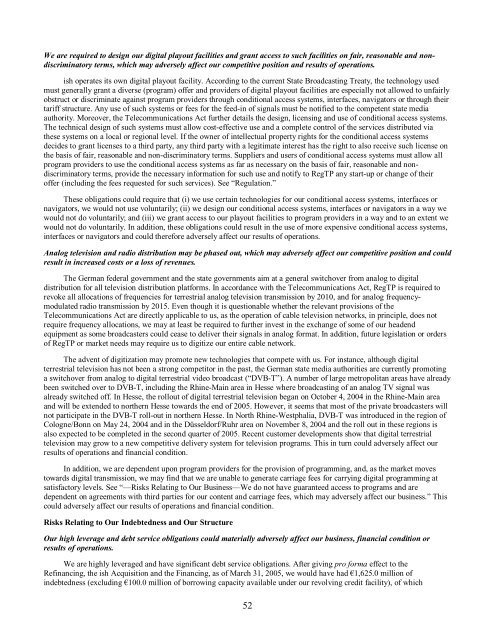iesy Repository GmbH - Irish Stock Exchange
iesy Repository GmbH - Irish Stock Exchange
iesy Repository GmbH - Irish Stock Exchange
Create successful ePaper yourself
Turn your PDF publications into a flip-book with our unique Google optimized e-Paper software.
We are required to design our digital playout facilities and grant access to such facilities on fair, reasonable and nondiscriminatory<br />
terms, which may adversely affect our competitive position and results of operations.<br />
ish operates its own digital playout facility. According to the current State Broadcasting Treaty, the technology used<br />
must generally grant a diverse (program) offer and providers of digital playout facilities are especially not allowed to unfairly<br />
obstruct or discriminate against program providers through conditional access systems, interfaces, navigators or through their<br />
tariff structure. Any use of such systems or fees for the feed-in of signals must be notified to the competent state media<br />
authority. Moreover, the Telecommunications Act further details the design, licensing and use of conditional access systems.<br />
The technical design of such systems must allow cost-effective use and a complete control of the services distributed via<br />
these systems on a local or regional level. If the owner of intellectual property rights for the conditional access systems<br />
decides to grant licenses to a third party, any third party with a legitimate interest has the right to also receive such license on<br />
the basis of fair, reasonable and non-discriminatory terms. Suppliers and users of conditional access systems must allow all<br />
program providers to use the conditional access systems as far as necessary on the basis of fair, reasonable and nondiscriminatory<br />
terms, provide the necessary information for such use and notify to RegTP any start-up or change of their<br />
offer (including the fees requested for such services). See “Regulation.”<br />
These obligations could require that (i) we use certain technologies for our conditional access systems, interfaces or<br />
navigators, we would not use voluntarily; (ii) we design our conditional access systems, interfaces or navigators in a way we<br />
would not do voluntarily; and (iii) we grant access to our playout facilities to program providers in a way and to an extent we<br />
would not do voluntarily. In addition, these obligations could result in the use of more expensive conditional access systems,<br />
interfaces or navigators and could therefore adversely affect our results of operations.<br />
Analog television and radio distribution may be phased out, which may adversely affect our competitive position and could<br />
result in increased costs or a loss of revenues.<br />
The German federal government and the state governments aim at a general switchover from analog to digital<br />
distribution for all television distribution platforms. In accordance with the Telecommunications Act, RegTP is required to<br />
revoke all allocations of frequencies for terrestrial analog television transmission by 2010, and for analog frequencymodulated<br />
radio transmission by 2015. Even though it is questionable whether the relevant provisions of the<br />
Telecommunications Act are directly applicable to us, as the operation of cable television networks, in principle, does not<br />
require frequency allocations, we may at least be required to further invest in the exchange of some of our headend<br />
equipment as some broadcasters could cease to deliver their signals in analog format. In addition, future legislation or orders<br />
of RegTP or market needs may require us to digitize our entire cable network.<br />
The advent of digitization may promote new technologies that compete with us. For instance, although digital<br />
terrestrial television has not been a strong competitor in the past, the German state media authorities are currently promoting<br />
a switchover from analog to digital terrestrial video broadcast (“DVB-T”). A number of large metropolitan areas have already<br />
been switched over to DVB-T, including the Rhine-Main area in Hesse where broadcasting of an analog TV signal was<br />
already switched off. In Hesse, the rollout of digital terrestrial television began on October 4, 2004 in the Rhine-Main area<br />
and will be extended to northern Hesse towards the end of 2005. However, it seems that most of the private broadcasters will<br />
not participate in the DVB-T roll-out in northern Hesse. In North Rhine-Westphalia, DVB-T was introduced in the region of<br />
Cologne/Bonn on May 24, 2004 and in the Düsseldorf/Ruhr area on November 8, 2004 and the roll out in these regions is<br />
also expected to be completed in the second quarter of 2005. Recent customer developments show that digital terrestrial<br />
television may grow to a new competitive delivery system for television programs. This in turn could adversely affect our<br />
results of operations and financial condition.<br />
In addition, we are dependent upon program providers for the provision of programming, and, as the market moves<br />
towards digital transmission, we may find that we are unable to generate carriage fees for carrying digital programming at<br />
satisfactory levels. See “—Risks Relating to Our Business—We do not have guaranteed access to programs and are<br />
dependent on agreements with third parties for our content and carriage fees, which may adversely affect our business.” This<br />
could adversely affect our results of operations and financial condition.<br />
Risks Relating to Our Indebtedness and Our Structure<br />
Our high leverage and debt service obligations could materially adversely affect our business, financial condition or<br />
results of operations.<br />
We are highly leveraged and have significant debt service obligations. After giving pro forma effect to the<br />
Refinancing, the ish Acquisition and the Financing, as of March 31, 2005, we would have had €1,625.0 million of<br />
indebtedness (excluding €100.0 million of borrowing capacity available under our revolving credit facility), of which<br />
52

















